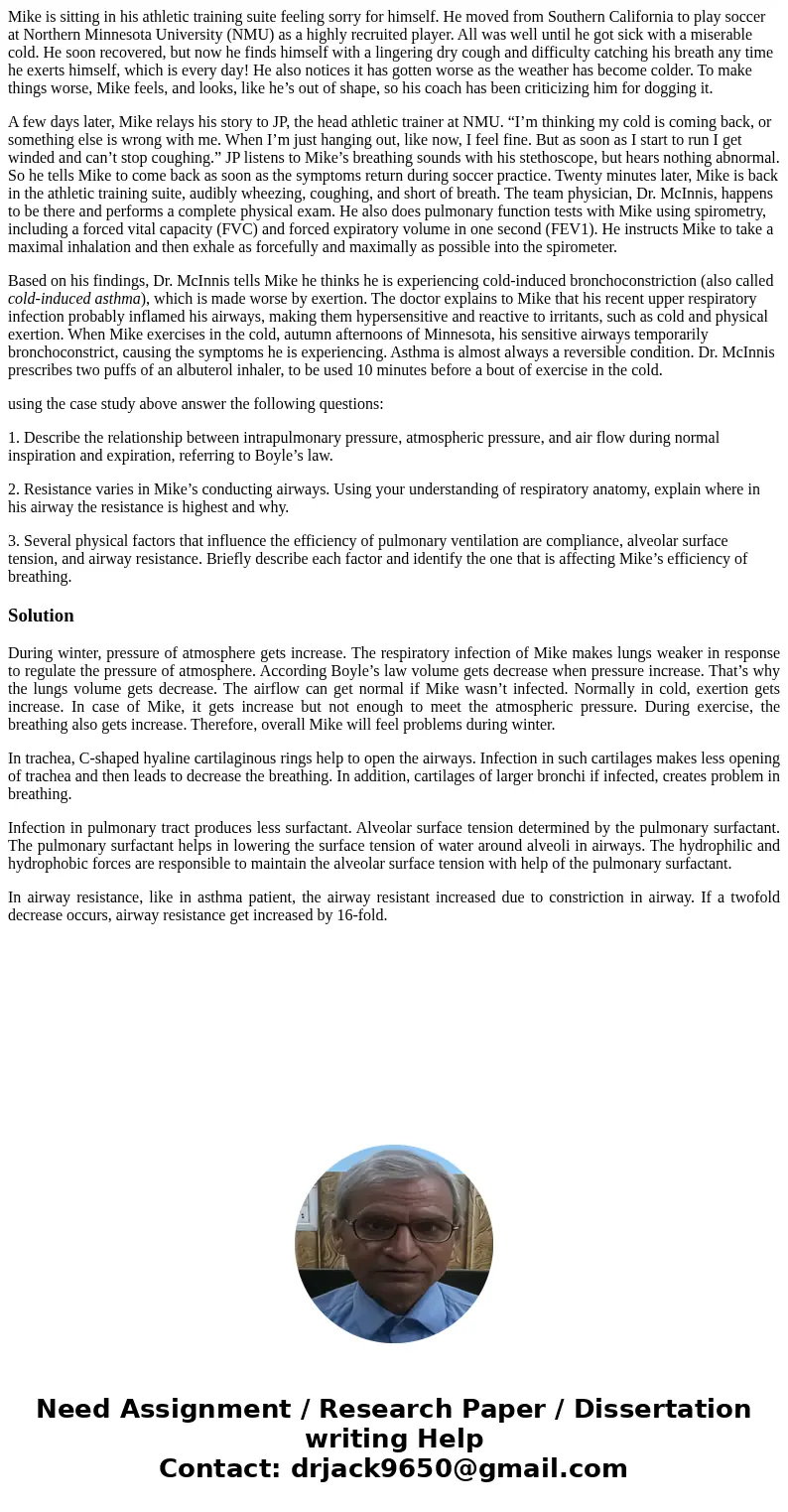Mike is sitting in his athletic training suite feeling sorry
Mike is sitting in his athletic training suite feeling sorry for himself. He moved from Southern California to play soccer at Northern Minnesota University (NMU) as a highly recruited player. All was well until he got sick with a miserable cold. He soon recovered, but now he finds himself with a lingering dry cough and difficulty catching his breath any time he exerts himself, which is every day! He also notices it has gotten worse as the weather has become colder. To make things worse, Mike feels, and looks, like he’s out of shape, so his coach has been criticizing him for dogging it.
A few days later, Mike relays his story to JP, the head athletic trainer at NMU. “I’m thinking my cold is coming back, or something else is wrong with me. When I’m just hanging out, like now, I feel fine. But as soon as I start to run I get winded and can’t stop coughing.” JP listens to Mike’s breathing sounds with his stethoscope, but hears nothing abnormal. So he tells Mike to come back as soon as the symptoms return during soccer practice. Twenty minutes later, Mike is back in the athletic training suite, audibly wheezing, coughing, and short of breath. The team physician, Dr. McInnis, happens to be there and performs a complete physical exam. He also does pulmonary function tests with Mike using spirometry, including a forced vital capacity (FVC) and forced expiratory volume in one second (FEV1). He instructs Mike to take a maximal inhalation and then exhale as forcefully and maximally as possible into the spirometer.
Based on his findings, Dr. McInnis tells Mike he thinks he is experiencing cold-induced bronchoconstriction (also called cold-induced asthma), which is made worse by exertion. The doctor explains to Mike that his recent upper respiratory infection probably inflamed his airways, making them hypersensitive and reactive to irritants, such as cold and physical exertion. When Mike exercises in the cold, autumn afternoons of Minnesota, his sensitive airways temporarily bronchoconstrict, causing the symptoms he is experiencing. Asthma is almost always a reversible condition. Dr. McInnis prescribes two puffs of an albuterol inhaler, to be used 10 minutes before a bout of exercise in the cold.
using the case study above answer the following questions:
1. Describe the relationship between intrapulmonary pressure, atmospheric pressure, and air flow during normal inspiration and expiration, referring to Boyle’s law.
2. Resistance varies in Mike’s conducting airways. Using your understanding of respiratory anatomy, explain where in his airway the resistance is highest and why.
3. Several physical factors that influence the efficiency of pulmonary ventilation are compliance, alveolar surface tension, and airway resistance. Briefly describe each factor and identify the one that is affecting Mike’s efficiency of breathing.
Solution
During winter, pressure of atmosphere gets increase. The respiratory infection of Mike makes lungs weaker in response to regulate the pressure of atmosphere. According Boyle’s law volume gets decrease when pressure increase. That’s why the lungs volume gets decrease. The airflow can get normal if Mike wasn’t infected. Normally in cold, exertion gets increase. In case of Mike, it gets increase but not enough to meet the atmospheric pressure. During exercise, the breathing also gets increase. Therefore, overall Mike will feel problems during winter.
In trachea, C-shaped hyaline cartilaginous rings help to open the airways. Infection in such cartilages makes less opening of trachea and then leads to decrease the breathing. In addition, cartilages of larger bronchi if infected, creates problem in breathing.
Infection in pulmonary tract produces less surfactant. Alveolar surface tension determined by the pulmonary surfactant. The pulmonary surfactant helps in lowering the surface tension of water around alveoli in airways. The hydrophilic and hydrophobic forces are responsible to maintain the alveolar surface tension with help of the pulmonary surfactant.
In airway resistance, like in asthma patient, the airway resistant increased due to constriction in airway. If a twofold decrease occurs, airway resistance get increased by 16-fold.

 Homework Sourse
Homework Sourse